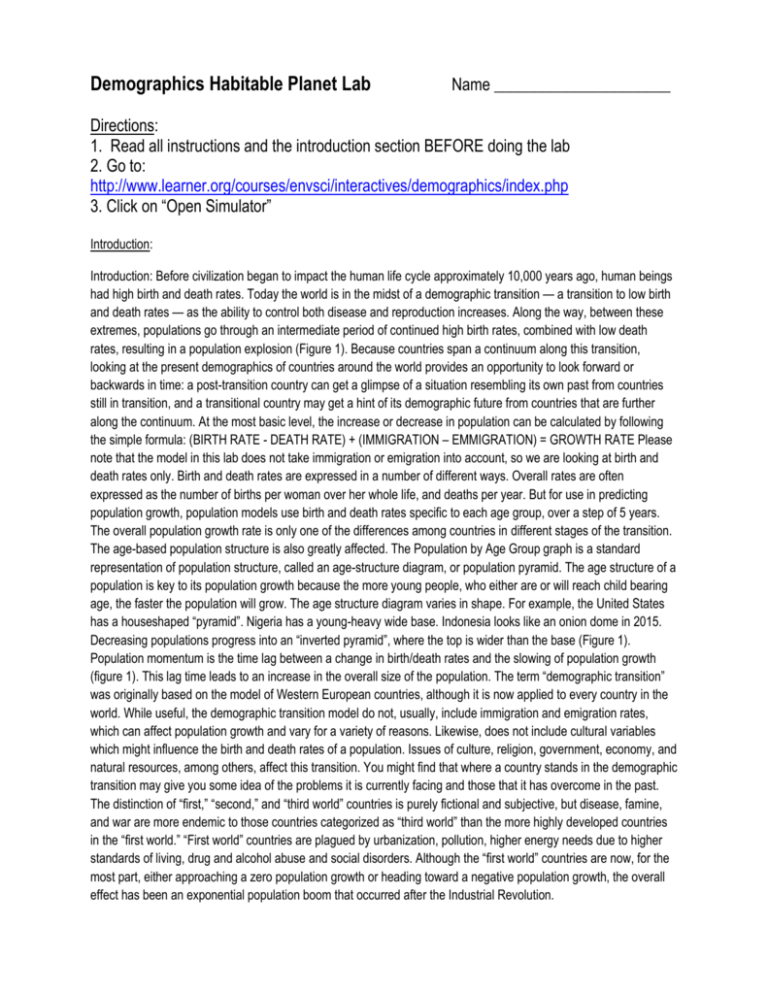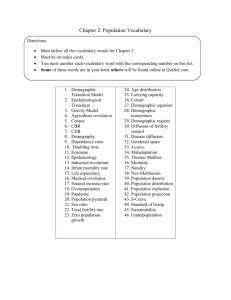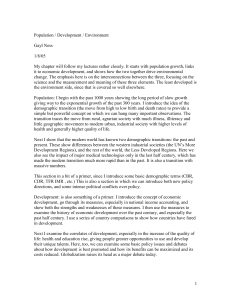Demographics Lab: Population Growth & Transition
advertisement

Demographics Habitable Planet Lab Name ______________________ Directions: 1. Read all instructions and the introduction section BEFORE doing the lab 2. Go to: http://www.learner.org/courses/envsci/interactives/demographics/index.php 3. Click on “Open Simulator” Introduction: Introduction: Before civilization began to impact the human life cycle approximately 10,000 years ago, human beings had high birth and death rates. Today the world is in the midst of a demographic transition — a transition to low birth and death rates — as the ability to control both disease and reproduction increases. Along the way, between these extremes, populations go through an intermediate period of continued high birth rates, combined with low death rates, resulting in a population explosion (Figure 1). Because countries span a continuum along this transition, looking at the present demographics of countries around the world provides an opportunity to look forward or backwards in time: a post-transition country can get a glimpse of a situation resembling its own past from countries still in transition, and a transitional country may get a hint of its demographic future from countries that are further along the continuum. At the most basic level, the increase or decrease in population can be calculated by following the simple formula: (BIRTH RATE - DEATH RATE) + (IMMIGRATION – EMMIGRATION) = GROWTH RATE Please note that the model in this lab does not take immigration or emigration into account, so we are looking at birth and death rates only. Birth and death rates are expressed in a number of different ways. Overall rates are often expressed as the number of births per woman over her whole life, and deaths per year. But for use in predicting population growth, population models use birth and death rates specific to each age group, over a step of 5 years. The overall population growth rate is only one of the differences among countries in different stages of the transition. The age-based population structure is also greatly affected. The Population by Age Group graph is a standard representation of population structure, called an age-structure diagram, or population pyramid. The age structure of a population is key to its population growth because the more young people, who either are or will reach child bearing age, the faster the population will grow. The age structure diagram varies in shape. For example, the United States has a houseshaped “pyramid”. Nigeria has a young-heavy wide base. Indonesia looks like an onion dome in 2015. Decreasing populations progress into an “inverted pyramid”, where the top is wider than the base (Figure 1). Population momentum is the time lag between a change in birth/death rates and the slowing of population growth (figure 1). This lag time leads to an increase in the overall size of the population. The term “demographic transition” was originally based on the model of Western European countries, although it is now applied to every country in the world. While useful, the demographic transition model do not, usually, include immigration and emigration rates, which can affect population growth and vary for a variety of reasons. Likewise, does not include cultural variables which might influence the birth and death rates of a population. Issues of culture, religion, government, economy, and natural resources, among others, affect this transition. You might find that where a country stands in the demographic transition may give you some idea of the problems it is currently facing and those that it has overcome in the past. The distinction of “first,” “second,” and “third world” countries is purely fictional and subjective, but disease, famine, and war are more endemic to those countries categorized as “third world” than the more highly developed countries in the “first world.” “First world” countries are plagued by urbanization, pollution, higher energy needs due to higher standards of living, drug and alcohol abuse and social disorders. Although the “first world” countries are now, for the most part, either approaching a zero population growth or heading toward a negative population growth, the overall effect has been an exponential population boom that occurred after the Industrial Revolution. Demographic Transition Step 1 Challenge: Determine the growth rates of populations of different countries Instructions: 1. To get a sense of the demographic transition continuum, start by running the simulator to 2-5- for all 9 countries 2. Record their population growth rates at the end of the simulated period in the Data Tables. 3. Number and state the relative place in transition the countries are by growth rate from highest (earliest in demographic transition) to lowest (farthest along in transition) Steps 1 & 2 Country Birthrate (per female) Death Rate (percent) Population Growth 2015 Population Growth 2050 USA Brazil China India Indonesia Iraq Italy Japan Nigeria Step 3 Country USA Brazil China India Indonesia Iraq Italy Japan Nigeria Ranking Relative Place in Transition (see figure 1) Social Factors Analysis Questions: Answer the following thoroughly and in complete sentences. 1. How do you suppose living conditions differ between the countries the furthest along in the demographic transition compared to the country earliest in the transition? 2. How would living conditions in these how countries affect both birth and death rates? 3. Think of three social factors that contribute to the lower birth rates in the countries farther along. How could these social conditions be encouraged to emerge in less developed countries? 4. In general, how do the concepts of “early, middle, and late demographic transition” map to the concepts of “first, second, and third world countries?” 5. Refer to the age structure diagram. Compare the age structure diagrams at EACH demographic transition stage. Explain what the diagrams are indicating in terms of birth rate, death rate and age structure. 6. What challenges do countries in the low stationary or the declining stage face? 7. Summarize what you learned about demographics and the effect that each of the different stages have on our environment. Use specific examples. Analysis Questions: Answer the following thoroughly and in complete sentences. 1. How do you suppose living conditions differ between the countries the furthest along in the demographic transition compared to the country earliest in the transition? 2. How would living conditions in these how countries affect both birth and death rates? 3. Think of three social factors that contribute to the lower birth rates in the countries farther along. How could these social conditions be encouraged to emerge in less developed countries? 4. In general, how do the concepts of “early, middle, and late demographic transition” map to the concepts of “first, second, and third world countries?” 5. Refer to the age structure diagram. Compare the age structure diagrams at EACH demographic transition stage. Explain what the diagrams are indicating in terms of birth rate, death rate and age structure. 6. What challenges do countries in the low stationary or the declining stage face? 7. Summarize what you learned about demographics and the effect that each of the different stages have on our environment. Use specific examples.





